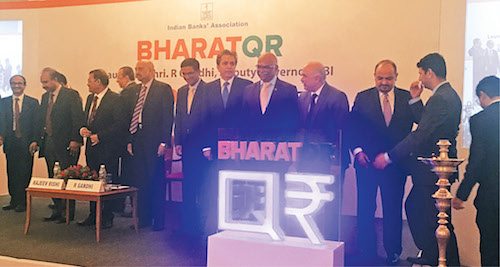- BharatQR code is a transformative step towards easing and encouraging cashless payments
- BharatQR is multi-purpose and can be applied in various facets of a business
Enterprises in India are finally waking up to the QR code technology. Taking a leaf from other countries, the Indian government has launched a common QR code, BharatQR, with the aim to ‘reform’ the payment systems in the country.
“BharatQR code is a transformative step towards easing and encouraging cashless payments. It makes digital payments far cheaper, and its key benefits like interoperability and seamless transactions make it extremely attractive for both merchants and customers,” shares Kishore Biyani, CEO of Future Group.
“At Future Group, we are experimenting with the technology with the objective to roll it out in our stores in the near future. However, we believe there will be even more innovation in the payments area in the near future that will make digital transactions even more intuitive, easy and accessible for every segment of Indian citizens. BharatQR code is a big step towards this direction,” Biyani adds.
While the government might have wanted to only change the payment mechanisms in the country, this revolutionary technology is actually multi-purpose and can be applied in various facets of a business.
Increase sales
No retailer can ignore the fact that most customers today first go online to do their research (for reviews, best price and quality of products) before buying a product. And not all are willing to come to the physical store to shop what they want. With the infrastructure for a common QR Code already laid down, companies can generate their code on BharatQR and display it on their online store. When customers visit their online sites to see what is available in their stores, they can order and use the QR code to scan the payment. This allows companies to sell the stocks available in their brick-and-mortar stores, thus substantially increasing their sales.

Back in 2011, Verizon achieved a 200 per cent increase in its sales using QR codes. The company simply displayed QR codes in-stores that enabled customers to enter a competition. Customers were required to share the brand’s advertisements on social media, and if their friend bought a product, they would get a smartphone. According to reports, the company clocked in an additional $35,000 in sales while the investment was just $1000.
Another way to increase sales is to display the BharatQR code in print advertisements or billboards, which takes customers directly to the company’s website once they scan the code. The company can then process customers’ orders and take the payment using the same QR code, thus saving both time and money in the process.
A Vancouver-based coffee roaster, Ethical Bean, started using QR codes to attract customers. The company displayed QR codes in its train ads, which, when scanned, took customers directly to the cafe’s menu. This allowed customers to place their orders on the go, thus eliminating the waiting time while helping the cafe clock-in higher sales. Lloyd Bernhardt of Ethical Bean told Wall St Journal that the technology helped them double their business.
Cut unnecessary costs
For any retailer, installing a point-of-sale (PoS) machine is both a capital expenditure as well as operational expenditure. And even though it makes up a little less than 10 per cent of the total operating cost for a retailer, every expenditure eats into the profit-pie of the company.
A PoS machine has intangible costs associated with it. It can cost up to Rs. 15,000 and usually comes with a monthly maintenance charge, performance charge along with merchant discount charges (MDR). The MDR for a retailer varies from 0.25 per cent to 0.50 per cent for transactions up to Rs. 1000 and Rs. 2000, respectively. For transactions made from credit cards, there is no cap and sometimes it can go up to 2 per cent of the transaction value. For a transaction value above Rs. 2000, the MDR is one per cent of the total bill amount.
“While PoS machines may not contribute significantly to the operating costs of a large retail chain, a common QR code will definitely help medium- and small-scale retailers become more efficient. They just need to get a printout and stick it at the counter,” says fintech expert Abhishant Pant.
Besides, the on-site maintenance of PoS machines is high and is a running cost throughout the lifespan of the machine. For instance, the rental for a PoS machine, depending on its type, is anywhere between Rs. 400 and Rs. 1500. Also, some PoS machines have performance charges ranging from Rs. 250 to Rs. 500.
However, using BharatQR, retailers can eliminate this expense. The cost involved is negligible as it only requires the retailer to display the QR code on a piece of paper. The MDR is also lower.
Apart from this, retailers need not pay any third-party fee to the payment gateway as BharatQR code is a common code that can accept payments from all three payment gateways—Visa, MasterCard and RuPay.

Effective marketing
American fast-food restaurant Taco Bell managed to garner over 200,000 scans using QR codes in its promotional campaign for ESPN College Football around the Bowl Championship Series in 2013. The brand managed to engage a substantial number of customers by using QR codes smartly.
Seamless customer experience
The waiting time for a customer is a key factor in determining the footfall of a retail store. The longer the queue, the more likely the customer is to avoid the store. So, retailers are devising ways to reduce the waiting time at the queue in order to give customers a more seamless experience. BharatQR seems to address this concern to some extent. With PoS machines, consumers have to swipe their cards, enter their PIN and wait for the machine to generate receipts. While in the case of BharatQR, all that customers need to do is to scan the QR code before them and enter the PIN, to get the payment done.







